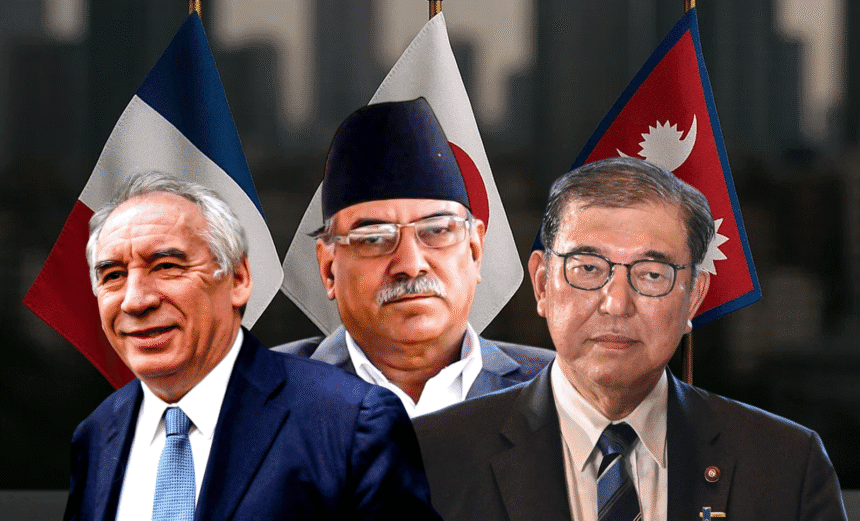In the span of just three days, three governments on three different continents have collapsed or resigned, revealing a moment of extraordinary political turbulence in the global order. Nepal, France, and Japan each experienced shakeups between September 7 and September 10, 2025, for very different reasons but with a common thread: a crisis of legitimacy fueled by discontent over corruption, economic hardship, and the inability of ruling elites to respond to the demands of their people.
In Nepal, frustration reached boiling point after the government imposed a sudden ban on social media platforms. What began as anger over digital restrictions quickly transformed into a mass movement led primarily by Generation Z, who were already incensed by entrenched corruption, nepotism, and lack of opportunity. Protests swept Kathmandu and other cities, some turning violent, leaving at least 19 dead and government buildings damaged. The demonstrations forced Prime Minister Pushpa Kamal Dahal to step aside, and Sushila Karki, a former chief justice and the country’s first female prime minister, was sworn in as interim leader. Parliament has been dissolved, and elections are scheduled for March 2026, but the question remains whether deeper reforms will follow or if the cycle of instability will repeat itself.
France’s turmoil took a different form but stemmed from similar frustrations. Prime Minister François Bayrou’s government collapsed after losing a confidence vote in the National Assembly. The defeat came as his administration pushed unpopular austerity measures aimed at cutting public spending and reducing ballooning debt. Lawmakers from across the spectrum voted against him, exposing President Emmanuel Macron’s weakened grip on a fractured legislature. Macron must now appoint another prime minister capable of commanding support in a parliament divided between far-left, far-right, and centrist blocs. Meanwhile, French citizens, already staging protests against cuts to public services, are bracing for more uncertainty, fearing further political paralysis if no workable coalition emerges.
Japan’s crisis unfolded through electoral defeat rather than mass protests or parliamentary rebellion. Prime Minister Shigeru Ishiba resigned after his Liberal Democratic Party suffered historic losses in July’s upper house elections and subsequently lost its majority in both chambers. Public anger over rising inflation, stagnant wages, and the high cost of living eroded faith in the long-dominant party. Pressure within the LDP itself mounted, and Ishiba stepped down in recognition of the weakened mandate. A leadership race is now under way, with candidates such as Sanae Takaichi and Shinjiro Koizumi positioning themselves as potential successors. Markets reacted nervously, with the yen weakening and bond yields rising amid concerns that political uncertainty could stall economic policy.
Despite their differences, these three political collapses share striking similarities. Each reflects a loss of public trust, whether through outright protests, legislative rejection, or voter backlash. Economic grievances played a central role whether in the form of inflation in Japan, austerity in France, or economic stagnation and corruption in Nepal. In all three countries, young people are emerging as a decisive force, either in the streets or at the ballot box, demanding accountability from leaders seen as disconnected from daily struggles.
The immediate reactions also underline broader dynamics. In Nepal, protestors celebrated the symbolic victory of seeing an interim female prime minister take office, though many remain skeptical about promises of reform. In France, opposition parties claimed Bayrou’s downfall as a triumph, while Macron faces mounting pressure to bridge a divided legislature. In Japan, the resignation has set off intense jockeying within the ruling party, while ordinary citizens remain focused on whether new leadership can bring relief from economic pressures.
Looking at the past, all three countries have histories of political turbulence. Nepal has long struggled with unstable coalitions and governance challenges since the monarchy was abolished in 2008. France, under Macron, has faced repeated protests, from the “yellow vest” movement to pension reform strikes, while political fragmentation has deepened since 2024. Japan, though dominated by the LDP for decades, has seen its grip weaken as economic challenges persist, making this resignation one of the most significant leadership changes in recent years.
The future is far from certain. Nepal heads toward elections that could reshape its political order, though the risk of further instability is high. France may see ongoing legislative deadlock unless Macron can negotiate new alliances. Japan’s leadership contest will decide not just a new prime minister but potentially the trajectory of its economic and foreign policy. Collectively, these shakeups illustrate the fragility of even established democracies when confronted with eroding legitimacy and mounting social pressure.
On a global scale, the near-simultaneous fall of three governments underscores how interconnected the challenges of governance have become. Rising costs of living, corruption scandals, and unpopular austerity resonate across borders. Citizens everywhere appear less willing to tolerate mismanagement, with youth movements and voters alike ready to push back against ruling elites. For global markets, the uncertainty in France and Japan, two major economies, may reverberate through trade, investment, and international alliances. And in Nepal, the rise of youth activism may inspire similar movements in other regions grappling with corruption and inequality.
Ultimately, the message from Kathmandu, Paris, and Tokyo is clear: political legitimacy can no longer be taken for granted. In a world where public frustration can spark protests, topple cabinets, or sweep away parliamentary majorities in a matter of days, governments everywhere face a stark warning adapt to the people’s demands, or risk collapse.















